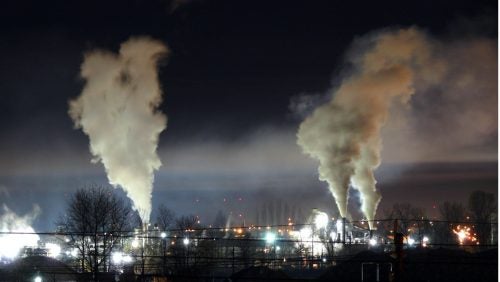Gone with the Wind? The Supreme Court Agrees to Review the EPA’s Power to Regulate Carbon Emissions Under the Clean Air Act
November 7, 2021 by Yanai Ben Gigi

Smokestacks at an industrial plant
The Supreme Court will soon hear a case that may alter the regulation of carbon dioxide emissions under the Clean Air Act and expand the reach of the nondelegation doctrine.
In April 2021, West Virginia filed a petition for certiorari, which the Supreme Court granted.[1] The petition challenges the United States Court of Appeals for the District of Columbia Circuit’s (“D.C. Circuit”) decision in American Lung Ass’n v. EPA,[2] interpreting the Clean Air Act (CAA) § 111(a), (d); 42 U.S.C. § 7411(a), (d).
In American, the D.C. Circuit reviewed the Environmental Protection Agency’s decision to issue a new emissions standard for existing stationary sources of air pollution, like powerplants and factories, after the agency had concluded that the language of the Clean Air Act did not support its previous policy. [3] Under the Clean Air Act, the EPA limits the permissible pollution rates of new and existing stationary sources.[4] To do so, the agency sets pertinent “standards of performance” which these sources must observe.[5] The EPA sets the standards for new stationary sources directly. However, the Clean Air Act “create[d] a partnership between the EPA and states…the EPA establishes emission guidelines, and the states take the lead on implementing them.” 80 Fed. Reg. 64,662 (Oct. 23, 2015). In short, the EPA determines the standard, and the states then submit a plan implementing the EPA standard for existing sources.[6]
In 2015, the EPA established the Clean Power Plan, a standard to regulate greenhouse emissions from existing sources.[7] The agency combined three measures to establish the “best system of emissions reduction”: (1) improving heat rates; (2) using natural gas in steam plants; (3) using new-zero emitting renewable sources in fossil-fuel-fired plants. The standard was viewed as impervious to costs; numerous parties unsuccessfully petitioned the D.C. Circuit to stay its operation. Subsequently, West Virginia successfully petitioned the Supreme Court to stay the plan.[8] In 2019, the EPA repudiated the Clean Power Plan, arguing that the statute’s language only allowed it to set standards that were “source-specific,” and published a different rule accordingly.[9]
Two years later, in American, the D.C. Circuit rejected the EPA’s basis for repudiating the Clean Power Plan.[10] The D.C. Circuit found that nothing in the Clean Air Act’s text constrained the EPA to set only “source-specific” standards.[11] The D.C. Circuit vacated and remanded the EPA’s new rule.[12] EPA sought to initiate a new rule-making process, stated that it would not reinstate the Clean Power Plan, and successfully moved to stay the D.C. Circuit’s vacatur.
In its petition for certiorari, West Virginia relies on the language and the structure of the Clean Air Act to argue that the Act created two types of programs: target-based, directing a specific result, and process-based, requiring improving processes and controls over time.[13] According to West Virginia, the latter programs—under which the “existing stationary sources” allegedly fall—are wholly “source-specific programs.”[14] West Virginia argues that even though the EPA was not going to reinstate the Clean Power Plan, the D.C. Court has given the agency a mandate to promulgate its substantial equivalent. Most significantly, West Virginia argues that if the D.C. Circuit’s interpretation of the statute is correct, the EPA’s discretion would be so wide-ranging and amorphous that it would violate the Supreme Court’s recent nondelegation case law.[15] In response, the EPA has argued that West Virginia has no standing, as the Clean Power Plan has been repudiated.[16] The EPA also argued that the petition was premature, as the rule-making process was ongoing and its results speculative.[17]
If the Supreme Court complies with West Virginia’s request and issues a decision on the merits of the case, some of the open questions plaguing the Clean Air Act’s caselaw and the modern nondelegation doctrine may be answered at last.
[1] See Petition for a Writ of Certiorari at 1, West Virginia v. EPA, No. 20-1530 (U.S. Apr. 29, 2021).
[2] F.3d 914 (D.C. Cir. 2021).
[3] Id. at 945 (Citing the EPA’s statement that “[t]he Agency now recognizes that Congress ‘spoke to the precise question’ of the scope [of the section] . . . and clearly precluded the unsupportable reading of that provision asserted [previously].”)
[4] See CAA § 111(b)(1), (d)(1); 42 U.S.C. § 7411(b)(1), (d)(1).
[5] See CAA § 111(a)(1); 42 U.S.C. § 7411, defining “standard[s] of performance,” meaning “standard of emissions of air pollutants which reflects the degree of emission limitation achievable through the application of the best system of emission reduction which . . . the Administrator determines has been adequately demonstrated.”
[6] See CAA § 111(d)(1); 42 U.S.C. § 7411(d)(1); see also Am. Lung Ass’n, 985 F.3d at 931–32.
[7] See 80 Fed. Reg. 64,662 (Oct. 23, 2015).
[8] See Petition Application at 36, West Virginia v. EPA, 136 S. Ct. 1000 (2016) (No. 15A773).
[9] See Am. Lung Ass’n, 985 F.3d at 945–46.
[10] Id.
[11] Id.
[12] Id. at 995.
[13] See Petition, supra note 1, at 3–4.
[14] Id. at 5.
[15] Id. at 32–35.
[16] See Brief for the Federal Respondents in Opposition at 17–19, West Virginia v. EPA, No. 20-1530 (U.S. Aug. 05, 2021).
[17] Id. at 20–22.

